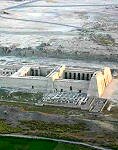|
|
|
temple facts
For best results, we recommend that you maximise this window.
Listed below are descriptions of the common terms and words used to describe various architectural and religious practices associated with temple life in Ancient Egypt:
| TERM |
PICTURE |
MEANING/DESCRIPTION |
| Pylons |
 |
Massive ceremonial gateways of two tapering towers linked by a bridge of stone, often creating a central "gateway" into the temple. Pylons were usually decorated in large reliefs which tended to symbolise royal power - a popular image was that of a large pharaoh smiting his much smaller enemies. Approaching the great pylons was usually a processional way, leading up to the gateway set between the towers. This would lead into the Outer Court.
|
| The Outer and Inner Courts |
 |
Outer Court: Passing through the "gateway" between the pylons, the worshipper would now be in the Outer Court of the temple. Shrines with statues of gods, both the temple's main deity and other gods were often found here, and the worshipper could honour these, perhaps by leaving offerings or praying by them. The general worshipper was probably not allowed further into the temple building than this. Here he would be met by the priests who would have received any offerings proffered.
Inner Court: Often yet another pair of pylons had to be passed before the inner court was reached. Reliefs on the walls often depicted the pharaoh in battle or making offerings to the gods. The general public may have been granted access to watch some of the rites on festival days.
|
| Hypostyle hall |
 |
The Hypostyle hall was a large temple court filled with tall stone columns, lit only by windows in the upper walls. The columns could be of varying height and diameter, although those that lined the axis route of the temple were usually the widest and tallest. Arranged in groups, they were richly decorated with painted reliefs depicting deities and religious symbols. Their capitals were often formed as lotuses, papyruses or palms. Smaller side doors, intended for bringing in offerings, would lead into the halls. The hypostyle hall was accessible only to the priests, and symbolised a reed swamp growing at the edges of the Primeval Mound.
|
| Sanctum |
 |
The floor sloped steadily upwards until the sanctum was reached, symbolically recreating the Primeval Mound. This was a small, dark room, where the cult statue was kept, usually in a shrine and hidden from view. The sanctuary was regarded as the innermost chamber of the god's home, and was the most restricted area of the temple, accessible usually to only the pharaoh or high priests.
|
| Cult/cult statue |
 |
This is the term used to refer to the worship of a particular deity, which was usually located in or around certain regions or towns, for instance, the cult of Isis at the temple of Philae in Aswan. Cult statues were images of the god or deity that would be placed in the temple shrine, or in miniature temples or barque-shrines.
|
| Shrine or Naos |
 |
The innermost sanctuary of the temple where either the cult statue, or the deity's barque was placed. The term shrine is also applied to the elaborate boxes containing funerary statuary, such as in the tomb of Tutankhamun. Small barque-shrines were often placed along processional ways as temporary resting places for the divine barque. Naos is an ancient Greek term for the innermost part of a temple or shrine. This term is used by Egyptologists to refer to a type of shrine containing the cult image or divine barque of the deity kept in the sanctuary.
|
| Barque |
 |
A scale model of a Nile boat, with the prow and stern adorned with the "aegis" (shield) of the god or deity, and a "naos" (shrine) where the cabin would have been which contained the cult image. Solar barques, such as those discovered at the Giza pyramids, were specialised funerary ritual boats, which may have been intended to carry the deceased through the underworld.
|
| Sacred lake |
 |
An artificially formed lake located within the precincts of many Egyptian temples. The sacred lake would act as a setting for the sailing of divine barques containing the images of the gods. It was also the home of sacred aquatic animals such as geese or crocodiles, and a source of pure water for daily ablutions.
|
| Priests |
 |
Ancient Egyptian priests were officials who were employed at the temple to look after the daily needs of the cult statue. Priests were not necessarily religious, some inherited the post from their father, in certain circumstances, priestly offices could even be purchased. There were groups of priests who had specialist knowledge, others who taught writing and copied out texts, and others who attended to the economic organisation of the temple. Particular ranks of officials also wore special garments, such as the distinctive leopard skin worn by the "sem" priests.
|
See also: our list of ancient Egyptian temples >>
|
|
|









